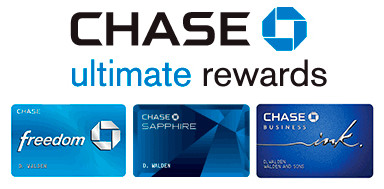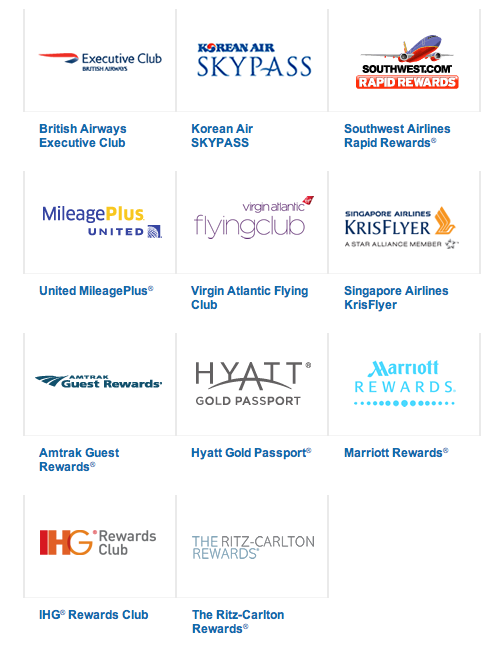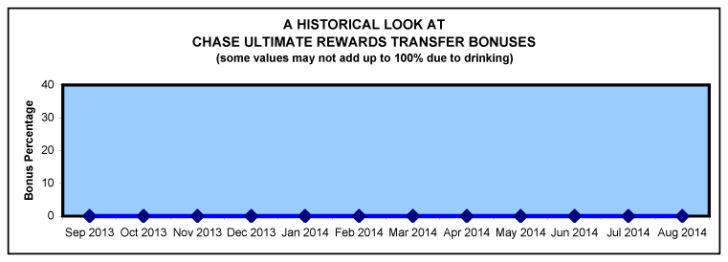
From the desk of the Devil’s Advocate…
This week we finish up our three-part series on the downsides of the major flexible miles currencies — Chase Ultimate Rewards, American Express Membership Rewards, and Starwood Preferred Guest (SPG) Starpoints. The wonderful features of these programs are frequently touted by the Conventional Wisdomers, and with good reason. But no loyalty program is ever perfect, and often the negatives of the Big Three go unmentioned.
Last Thursday we reviewed the issues with SPG Starpoints, and in the two weeks before that we covered the problems with American Express Membership Rewards (here as well). So now we’re ready to finish up by taking on the current king of the flexible programs, Chase Ultimate Rewards. Here’s why Chase UR points are painfully bad…
The Smallest List of Travel Partners
SPG has a huge list of nearly 30 airline and hotel transfer partners. It’s the strongest part of their program and a major benefit. American Express Membership Rewards has 21 travel partners, which isn’t quite as many but still gives you a pretty broad swath of choices.
But Chase only has 11 partners. That’s airlines and hotels combined. Eleven. Roughly half the partners of AmEx and just barely one-third the partners of SPG.

Now the Conventional Wisdomers will say you only need one high quality airline transfer partner (United) and one high quality hotel transfer partner (Hyatt) to make the points valuable. That’s true… right up until the moment that high quality partner has a massive devaluation. Such as, oh, I don’t know, maybe the one United had this past February where partner award prices went through the roof, jumping as much as 87% higher in some cases.
The whole point of flexible point currencies is to have more than one good transfer partner, because if the entire program is tied into one vital partner, you’re at the mercy of that partner. Yes, Chase has 5 other airline partners but almost every one of them has a major downside. Southwest has limited international routes, British Airways is useful for short haul but weak for anything longer, Virgin Atlantic loves passing along super high fuel surcharges, and Korean Air promises no online partner redemptions and a ton of hoops to jump through via phone redemptions.
The recent addition of Singapore Airlines as an airline partner has definitely helped offset the United devaluation but now we’re at the mercy of Singapore Airlines. When they decide to devalue on a whim, we’ll be right back here looking at high award prices and limited other options. Same with Hyatt if they one day decide to follow Hilton down the evil road of destroying their loyalty program (and kudos to Hyatt for so far appreciating their customers).
Looking For Transfer Bonuses? Not Here!
As we discussed last week, SPG has a standard 5,000 point bonus for every 20,000 Starpoints transferred to their travel partners. Membership Rewards has ongoing limited-time transfer bonuses for various partners throughout the year. Those transfer bonuses have been somewhat less generous in recent years, but you can still easily find 25%-40% bonuses on a regular basis. For instance, Membership Rewards is currently offering a 25% bonus on transfers to JetBlue through September 15, 2014.
But Chase Ultimate Rewards doesn’t have transfer bonuses. Not a one. You get a 1:1 ratio and nothing more. Ever.

I’m not the first one to note this rather glaring weakness in the Ultimate Rewards program, and it’s a bit odd that it hasn’t been addressed by Chase. Even a 15% transfer bonus a couple times a year would be extremely welcome. Perhaps it’s too much to expect a bonus for some of their better partners like Singapore or Hyatt, but how about a small transfer bonus on Southwest points for a limited time? Especially for a program like Southwest with fixed point values, a little transfer bonus would be a major plus for Ultimate Rewards.
If You Want To Transfer Points, You’ll Pay The Most With Chase
Up until this past March, Ultimate Rewards was similar to AmEx Membership Rewards in that you needed to carry one of their “premium” cards with an annual fee in order to transfer points to their travel partners. You can temporarily “store” the points in a no-fee card, but eventually you’ll need to pay $95 at least once (or keep churning cards to repeatedly get that first year with no annual fee) if you want more for those points than just a 1 cent per point cash redemption.
But then American Express leapfrogged ahead of Chase by introducing their Everyday cards, which maintain the ability to transfer points to travel partners but do so with no annual fee (at least for the basic card). Yes, SPG cards still carry an annual fee. But it’s only $65, a full $30 less than the cheapest premium Chase card available.
That puts Chase at the back of the pack and means you have to get an extra $30 of value out of your Ultimate Rewards points each year just to get back to even with SPG, and a full $95 in extra value to match Membership Rewards.
The Devil’s Advocate says Chase Ultimate Rewards is a few flaws short of perfect.
Let’s be frank here — of all my posts about the downsides of the flexible loyalty currency programs, this one is the shortest. It’s fair to say that while a more robust partner roster and an occasional transfer bonus would be nice additions to Chase Ultimate Rewards, it’s generally a pretty terrific program with generous signup bonuses, plentiful bonus categories, and instant transfers.
Chase may be the king of the moment, but what we’ve learned in the past month is that all three of the flexible currency programs could use a bit of fine tuning. What’s interesting to note is that many of these issues could be solved with minimal additional investment by the bank issuers. How hard would it be for SPG to have instant transfers? Couldn’t AmEx Membership Rewards have a reasonable transfer ratio to SPG itself, which would lift the value of both of those properties? Why can’t Chase let their Freedom cardholders use transfer partners just like their Sapphire Preferred and premium Ink cardholders do?
In life, nothing is perfect. Such is also the case in loyalty programs. We’ll keep wishing for that elusive goal, but we’ll probably always be reaching for the stars and never quite touching them.
Devil’s Advocate is a weekly series that deliberately argues a contrarian view on travel and loyalty programs. Sometimes the Devil’s Advocate truly believes in the counterargument. Other times he takes the opposing position just to see if the original argument holds water. But his main objective is to engage in friendly debate with the miles and points community to determine if today’s conventional wisdom is valid. You can suggest future topics by sending an email to dvlsadvcate@gmail.com.





